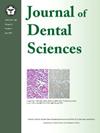GAS5通过作为miR-21的竞争内源性RNA,降低了槟茶碱诱导的颊粘膜成纤维细胞的活性
IF 3.1
3区 医学
Q1 DENTISTRY, ORAL SURGERY & MEDICINE
引用次数: 0
摘要
背景/目的口腔黏膜下纤维化(OSF)被认为是一种增加口腔癌风险的癌前病变。肌成纤维细胞是OSF病理性纤维化特征的主要细胞介质。因此,了解驱动肌成纤维细胞活化的分子机制对于开发有效的治疗干预措施至关重要。生长抑制特异性5 (GAS5)是一种长链非编码RNA,是OSF发病机制中的一种潜在调控因子,尽管其具体作用仍未明确。为了验证GAS5与其靶点miR-21之间的直接相互作用,我们进行了荧光素酶报告基因实验。采用qRT-PCR检测OSF组织中GAS5的表达水平。胶原凝胶收缩和跨井迁移试验用于评估肌成纤维细胞的功能活动。结果GAS5过表达可抑制TGF-β诱导的肌成纤维细胞活化,其表现为减少胶原凝胶收缩、细胞迁移和抑制TGF-β/Smad2信号通路。GAS5还能减弱槟榔碱诱导的肌成纤维细胞活化。在机制上,GAS5直接与miR-21相互作用,从而调节肌成纤维细胞的功能。结论我们的研究结果表明,GAS5通过靶向TGF-β/Smad2信号通路,调控miR-21,在OSF中抑制肌成纤维细胞活化中起重要作用。GAS5可能是预防和治疗OSF的一个新的治疗靶点。本文章由计算机程序翻译,如有差异,请以英文原文为准。
GAS5 decreased the arecoline-induced myofibroblasts activity in buccal mucosal fibroblasts via acting as a competing endogenous RNA for miR-21
Background/purpose
Oral submucous fibrosis (OSF) is recognized as a premalignant condition that increases the risk of oral cancer. Myofibroblasts are the primary cellular mediators of the pathological fibrosis characteristic of OSF. Consequently, understanding the molecular mechanisms that drive myofibroblast activation is crucial for the development of effective therapeutic interventions for this condition. Growth arrest-specific 5 (GAS5), a long non-coding RNA, represents a potential regulatory factor in OSF pathogenesis, although its specific role remains largely undefined.
Materials and methods
To validate the direct interaction between GAS5 and its target miR-21, a luciferase reporter assay was performed. qRT-PCR was employed to evaluate the expression levels of GAS5 in OSF tissues. Collagen gel contraction and transwell migration assays were utilized to assess myofibroblast functional activities.
Results
Our result validated overexpression of GAS5 inhibits TGF-β-induced myofibroblast activation, as evidenced by reduced collagen gel contraction, cell migration, and suppression of the TGF-β/Smad2 signaling pathway. GAS5 also attenuates arecoline-induced myofibroblast activation. Mechanistically, GAS5 directly interacts with and sponges miR-21, thereby modulating myofibroblast function.
Conclusion
Our findings suggest that GAS5 plays a crucial role in inhibiting myofibroblast activation in OSF by targeting the TGF-β/Smad2 signaling pathway and regulating the miR-21. GAS5 may represent a novel therapeutic target for the prevention and treatment of OSF.
求助全文
通过发布文献求助,成功后即可免费获取论文全文。
去求助
来源期刊

Journal of Dental Sciences
医学-牙科与口腔外科
CiteScore
5.10
自引率
14.30%
发文量
348
审稿时长
6 days
期刊介绍:
he Journal of Dental Sciences (JDS), published quarterly, is the official and open access publication of the Association for Dental Sciences of the Republic of China (ADS-ROC). The precedent journal of the JDS is the Chinese Dental Journal (CDJ) which had already been covered by MEDLINE in 1988. As the CDJ continued to prove its importance in the region, the ADS-ROC decided to move to the international community by publishing an English journal. Hence, the birth of the JDS in 2006. The JDS is indexed in the SCI Expanded since 2008. It is also indexed in Scopus, and EMCare, ScienceDirect, SIIC Data Bases.
The topics covered by the JDS include all fields of basic and clinical dentistry. Some manuscripts focusing on the study of certain endemic diseases such as dental caries and periodontal diseases in particular regions of any country as well as oral pre-cancers, oral cancers, and oral submucous fibrosis related to betel nut chewing habit are also considered for publication. Besides, the JDS also publishes articles about the efficacy of a new treatment modality on oral verrucous hyperplasia or early oral squamous cell carcinoma.
 求助内容:
求助内容: 应助结果提醒方式:
应助结果提醒方式:


